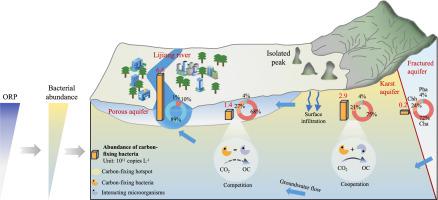当前位置:
X-MOL 学术
›
Water Res.
›
论文详情
Our official English website, www.x-mol.net, welcomes your feedback! (Note: you will need to create a separate account there.)
Carbon-fixing bacteria in diverse groundwaters of karst area: Distribution patterns, ecological interactions, and driving factors
Water Research ( IF 11.4 ) Pub Date : 2024-06-20 , DOI: 10.1016/j.watres.2024.121979 Yi Li , Danni Zhu , Lihua Niu , Wenlong Zhang , Longfei Wang , Huanjun Zhang , Shengzhang Zou , Changsong Zhou
Water Research ( IF 11.4 ) Pub Date : 2024-06-20 , DOI: 10.1016/j.watres.2024.121979 Yi Li , Danni Zhu , Lihua Niu , Wenlong Zhang , Longfei Wang , Huanjun Zhang , Shengzhang Zou , Changsong Zhou

|
The biological carbon pump in karst areas is of great significance for maintaining the effectiveness of karst carbon sinks. However, the spatial distribution and carbon-fixing potential of microorganisms in different aquifers within karst areas remain poorly understood. In this study, the distribution patterns, ecological roles, and environmental drivers of microbiota associated with CO fixation were investigated in karst groundwater (KW), porous groundwater (PW), fractured groundwater (FW), and surface water (SW) within a typical karst watershed, located in Guilin, southwest China. KW, PW, and FW displayed the similar community structure and indicative carbon-fixing bacteria composition, which were dominated by chemoautotrophic bacteria compared to SW. Higher abundances of indicative carbon-fixing bacteria and carbon-fixing genes, as well as richer proportions of microbial-derived DOC, indicated the more significant microbial carbon-fixing potential in KW and PW. At the profile of KW, a carbon-fixing hotspot was discovered at the depths of 0–50 m. Correlation analysis between carbon-fixing bacteria and DOC revealed that the chemoautotrophic process driven by nitrogen and sulfur oxidation predominated the microbial carbon fixation in groundwater. Co-occurrence network analysis demonstrated that carbon-fixing bacteria exhibited cooperation with other bacterial taxa in KW, while competition was the dominant interaction in PW. Moreover, carbon-fixing bacteria was found to lead bacterial assembly more deterministic in KW. The analysis of environmental factors and microbial diversity illustrated that inorganic carbon and redox state drove community variations across groundwaters. Structural equation model (SEM) further confirmed that ORP was the primary factor influencing the carbon fixation potential. This study provides a new insight into biological carbon fixation in karst aquatic systems, which holds significance in the accurate assessment of karst carbon sinks.
更新日期:2024-06-20











































 京公网安备 11010802027423号
京公网安备 11010802027423号